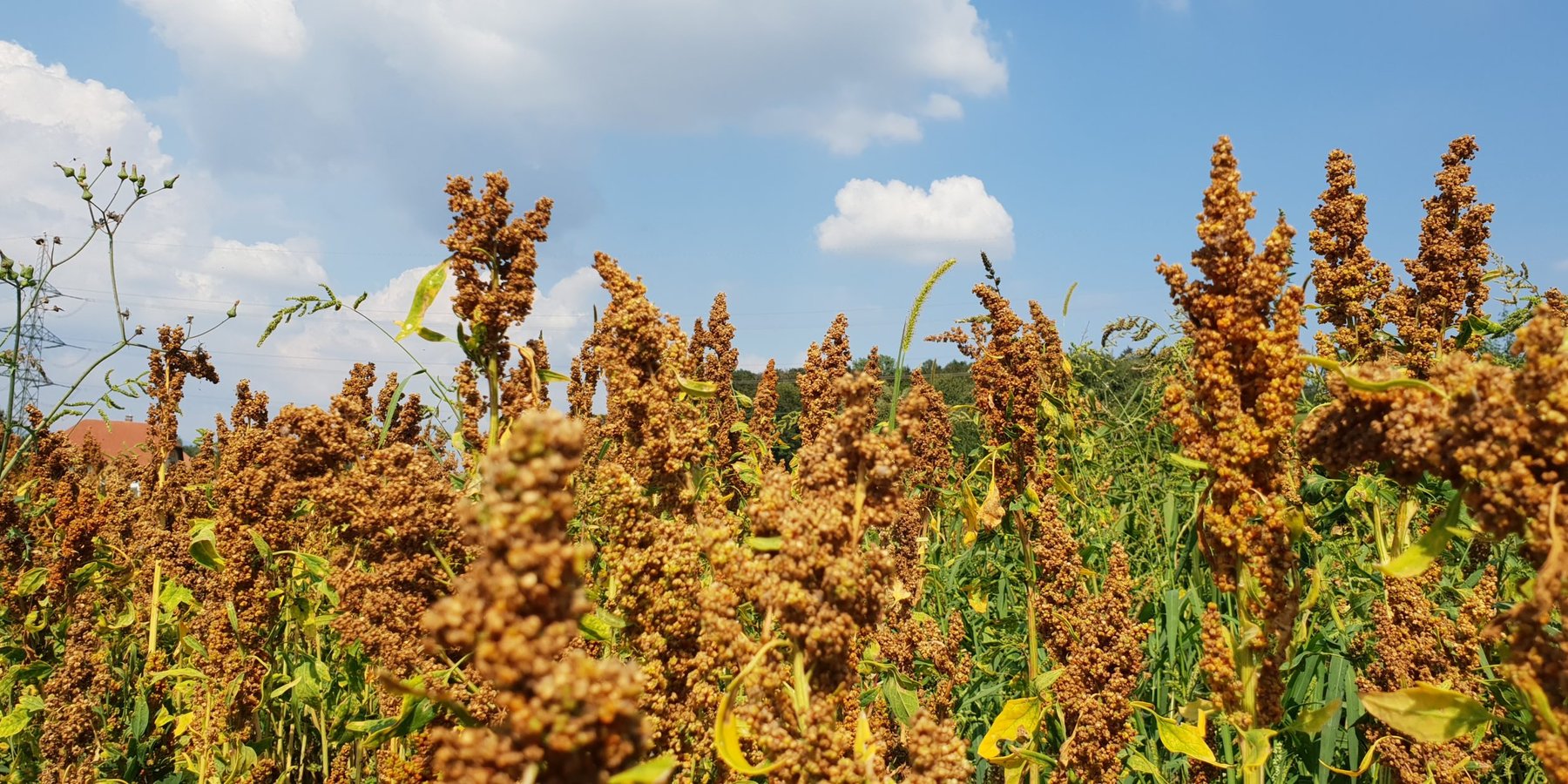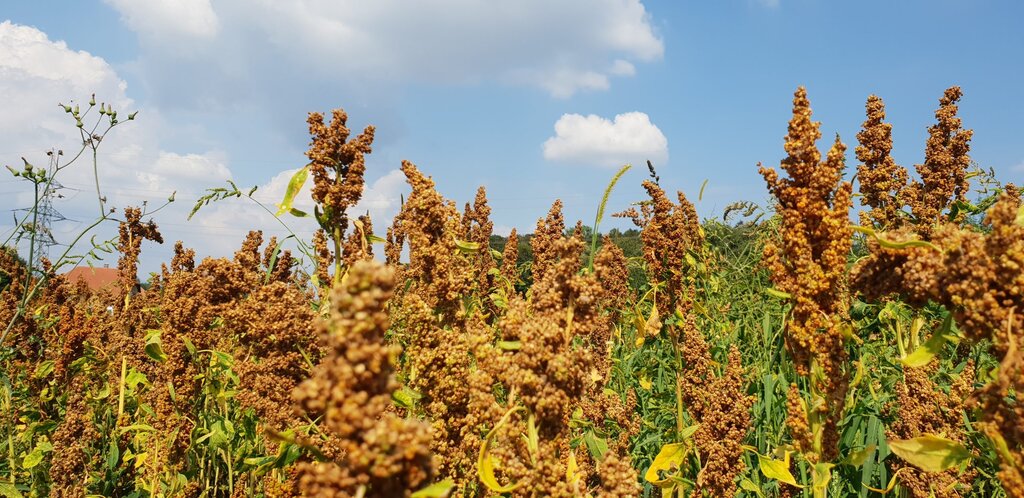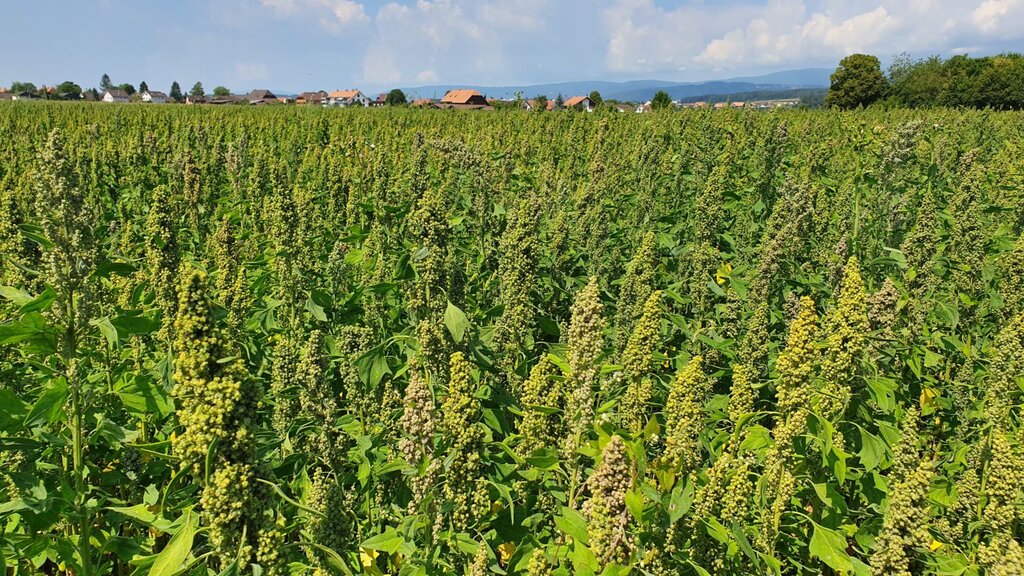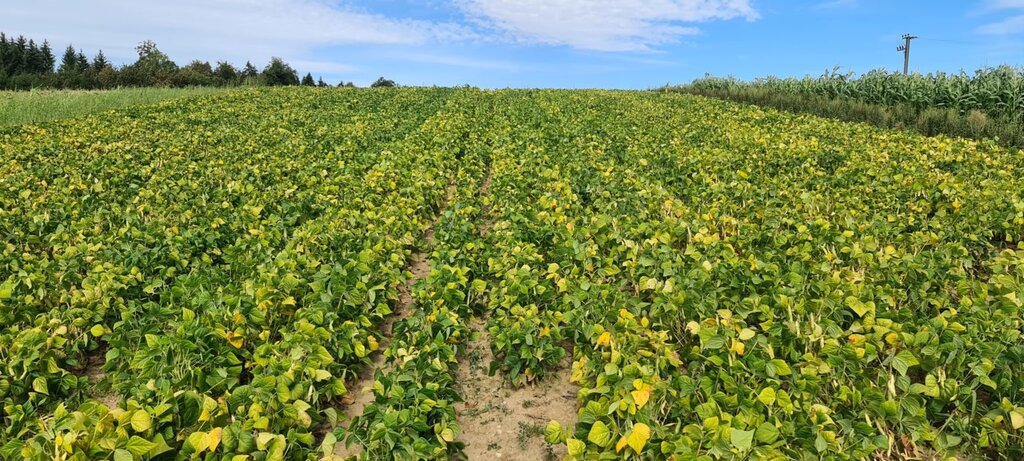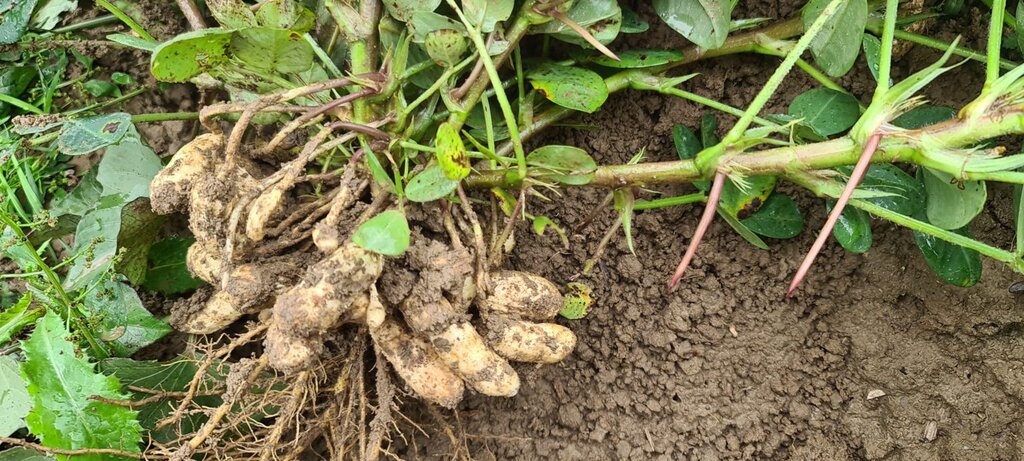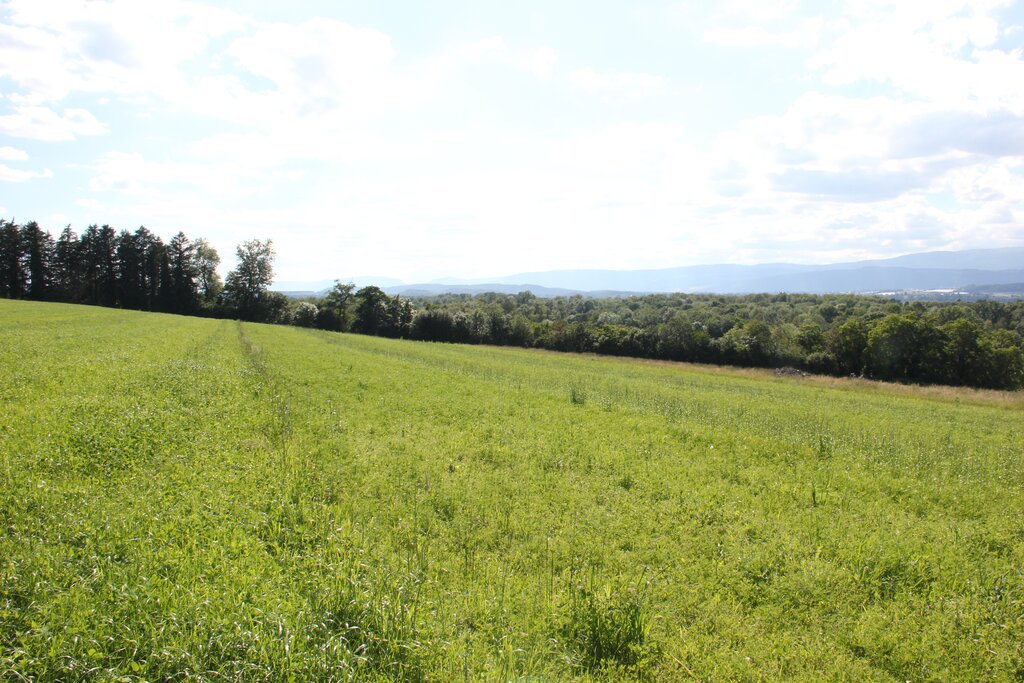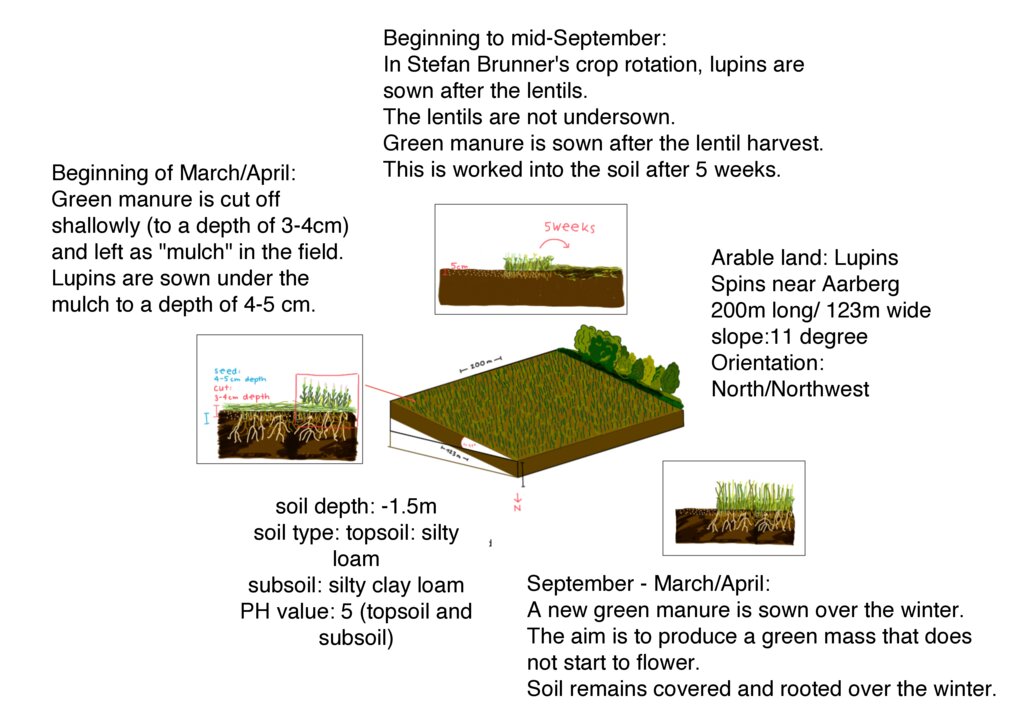Drought-resistant crops [ប្រទេសស្វ៊ីស]
- ការបង្កើត៖
- បច្ចុប្បន្នភាព
- អ្នកចងក្រង៖ Seraina Lerf
- អ្នកកែសម្រួល៖ Tatenda Lemann, Maria Eliza Turek, Joana Eichenberger
- អ្នកត្រួតពិនិត្យច្រើនទៀត៖ William Critchley, Rima Mekdaschi Studer
technologies_6272 - ប្រទេសស្វ៊ីស
ពិនិត្យមើលគ្រប់ផ្នែក
ពង្រីកមើលទាំងអស់ បង្រួមទាំងអស់1. ព័ត៌មានទូទៅ
1.2 ព័ត៌មានលម្អិតពីបុគ្គលសំខាន់ៗ និងស្ថាប័នដែលចូលរួមក្នុងការវាយតម្លៃ និងចងក្រងឯកសារនៃបច្ចេកទេស
បុគ្គលសំខាន់ម្នាក់ (ច្រើននាក់)
អ្នកប្រើប្រាស់ដី:
Brunner Stefan
Brunner Eichhof
ប្រទេសស្វ៊ីស
ឈ្មោះគម្រោងដែលបានចងក្រងឯកសារ/ វាយតម្លៃលើបច្ចេកទេស (បើទាក់ទង)
OPtimal strategies to retAIN and re-use water and nutrients in small agricultural catchments across different soil-climatic regions in Europe (OPTAIN)ឈ្មោះអង្គភាពមួយ (ច្រើន) ដែលបានចងក្រងឯកសារ/ វាយតម្លៃបច្ចេកទេស (បើទាក់ទង)
CDE Centre for Development and Environment (CDE Centre for Development and Environment) - ប្រទេសស្វ៊ីស1.3 លក្ខខណ្ឌទាក់ទងទៅនឹងការប្រើប្រាស់ទិន្នន័យដែលបានចងក្រងតាមរយៈ វ៉ូខេត
អ្នកចងក្រង និង(បុគ្គលសំខាន់ៗ)យល់ព្រមទទួលយកនូវលក្ខខណ្ឌនានាទាក់ទងទៅនឹងការប្រើប្រាស់ទិន្នន័យដែលបានចងក្រងតាមរយៈវ៉ូខេត:
បាទ/ចា៎
1.4 សេចក្តីប្រកាសស្តីពីចីរភាពនៃការពណ៌នាពីបច្ចេកទេស
តើបច្ចេកទេសដែលបានពណ៌នានេះមានបញ្ហាដែលផ្តោតលើការធ្លាក់ចុះគុណភាពដី, បើដូច្នេះវាមិនអាចត្រូវបានប្រកាសថាជាបច្ចេកទេសនៃការគ្រប់គ្រងប្រកបដោយចីរភាពទេ?
ទេ
2. ការពណ៌នាពីបច្ចេកទេស SLM
2.1 ការពណ៌នាដោយសង្ខេបពីបច្ចេកទេស
និយមន័យបច្ចេកទេស:
In response to changing environmental conditions, it can be valuable to adopt new plant varieties that offer benefits such as drought tolerance. The technology described covers one such response in Switzerland.
2.2 ការពណ៌នាលម្អិតពីបច្ចេកទេស
ការពណ៌នា:
In response to changing environmental conditions, it can be valuable to adopt new plant varieties that offer benefits such as drought tolerance. The key is the improved adaptation of the crops to heat and drought. These adaptations are based on plant physiological and morphological characteristics that confer increased drought tolerance, as well as phenology, which can also affect the plants' water requirements. The goal is to reduce production losses and promote a regional, plant-based food system in Switzerland. To introduce and maintain drought-resistant crops requires specific activities and inputs, such as selecting suitable seeds and ensuring long-term profitable cultivation. This technology is applied to cropland in Switzerland, especially in the Swiss Plateau, where climate change is causing increasingly warmer and drier summers, as well as more intense precipitation in the winter months. These climatic changes favour the cultivation of crops that can better cope with drought periods, allowing for the replacement of crops that require irrigation in the same growing areas.
The main purpose is to adapt agricultural production to the effects of climate change while simultaneously reducing the emissions caused by farming. By cultivating drought-resistant crops, the risk of production losses during drought periods can be minimized, and a transformation towards more diverse, plant-based, and regional food production systems can be promoted. A major advantage of this technology lies in the adaptability of the selected crops to climate change. Since they are better adapted to tolerating drought periods, no additional irrigation is needed: this saves labour and other resources. Moreover, growing drought tolerant crops enables the production of regional, plant-based, and protein-rich foods (especially legumes) that are appreciated by certain consumer groups and can be better marketed.
However, there are also challenges and disadvantages that are not yet appreciated by land users. The lack of knowledge about non-traditional crops in Switzerland is a significant problem. Both theoretical knowledge and practical experience in cultivation are lacking, leading to high risk for farmers who must experiment with cultivation. Additionally, despite climate scenarios predicting drier summers, there is still the risk of cool and wet summers with increased precipitation. Besides the biophysical challenges, there are also socio-economic obstacles, as the demand from wholesalers is often focused on traditional crops, and niche crops like millet are commonly not popular.
This documentation focuses on an example of an innovative farmer in Spins, Switzerland. Stefan Brunner has been testing a wide variety of drought-resistant legumes such as lentils, lupins and black runner beans on his Eichhof farm since 2017. In addition to the large-scale cultivation of these drought-resistant crops, he also cultivates quinoa, peanuts, chia, sorghum, millet and rice in a demonstration plot. Stefan Brunner simultaneously attaches great importance to sustainable cultivation methods which include surface tillage and mulching.
2.3 រូបភាពនៃបច្ចេកទេស
កំណត់សម្គាល់ទូទៅនៃរូបថត/រូភាព:
All pictures were taken on the agricultural land of Stefan Brunner in Spins near Aarberg. The pictures of the quinoa field, the bean cultivation and the peanut harvest were taken from the website of the Brunner family's Eichhof farm:
2.5 ប្រទេស/តំបន់/ទីតាំងកន្លែង ដែលបច្ចេកទេសត្រូវបានអនុវត្ត និងបានគ្រប់ដណ្តប់ដោយការវាយតម្លៃនេះ
ប្រទេស:
ប្រទេសស្វ៊ីស
តំបន់/រដ្ឋ/ខេត្ត:
western midlands of switzerland
បញ្ជាក់បន្ថែមពីលក្ខណៈនៃទីតាំង:
western midlands of switzerland (Broye catchment area), example farm in the canton of berne in Spins (near Aarberg)
បញ្ជាក់ពីការសាយភាយនៃបច្ចេកទេស:
- ត្រូវបានផ្សព្វផ្សាយត្រឹមតំបន់មួយ
ប្រសិនបើមិនច្បាស់ពីទំហំផ្ទៃដី សូមធ្វើការប៉ាន់ប្រម៉ាណ:
- 0.1-1 គម2
តើបច្ចេកទេស (មួយ ឬច្រើន) ទាំងនោះស្ថិតនៅក្នុងតំបន់ការពារជាអចិន្ត្រៃយ៍ណាមួយដែរឬទេ?
ទេ
មតិយោបល់:
The regions in which the technology is used are located in the agricultural zone of Switzerland
Map
×2.6 កាលបរិច្ឆេទនៃការអនុវត្ត
បង្ហាញឆ្នាំនៃការចុះអនុវត្ត:
2017
2.7 ការណែនាំពីបច្ចេកទេស
សូមបញ្ជាក់តើបច្ចេកទេសត្រូវបានណែនាំឱ្យអនុវត្តដោយរបៀបណា:
- តាមរយៈការបង្កើតថ្មីរបស់អ្នកប្រើប្រាស់ដី
3. ចំណាត់ថ្នាក់នៃបច្ចេកទេស SLM
3.1 គោលបំណងចម្បង (១ ឬច្រើន) នៃបច្ចេកទេសនេះ
- ធ្វើឱ្យប្រសើរឡើងនូវផលិតកម្ម
- កាត់បន្ថយ, បង្ការ, ស្តារឡើងវិញនូវការធ្លាក់ចុះគុណភាពដី
- បន្ស៊ាំទៅនឹងការប្រែប្រួលអាកាសធាតុ/គ្រោះមហន្តរាយ និងផលប៉ះពាល់របស់វា
- បង្កើតផលប្រយោជន៍សេដ្ឋកិច្ច
3.2 ប្រភេទដីប្រើប្រាស់មួយប្រភេទ (ច្រើនប្រភេទ) ដែលបានអនុវត្តបច្ចេកទេស
ដីប្រើប្រាស់ចម្រុះនៅលើដីតែមួយ:
ទេ

ដីដាំដំណាំ
- ដំណាំប្រចាំឆ្នាំ
ដំណាំប្រចាំឆ្នាំ - បញ្ជាក់ប្រភេទដំណាំ:
- ធញ្ញជាតិ - ពោត
- ធញ្ញជាតិ - quinoa ឬផ្ទី
- ធញ្ញជាតិ - ពោតសាលី
- ធញ្ញជាតិ - ស្រូវសាលី (សិសិររដូវរងារ)
- ដំណាំចំណីសត្វ - ស្មៅ
- legumes and pulses - lentils
ចំនួនសារដែលដាំដំណាំក្នុងមួយឆ្នាំ:
- 2
សូមបញ្ជាក់:
The number of growing seasons depends on the crops grown. With a crop rotation of 6 years, winter cereals, winter lentils/winter legumes and lupins are grown overlapping after three years of permanent grassland (grass production). Brunner also uses green manure between the different crops and therefore has around 2 growing seasons per year
តើជាការអនុវត្តន៍ដំណាំចន្លោះ?
ទេ
តើជាការអនុវត្តន៍ដំណាំវិលជុំ?
បាទ/ចា៎
បើបាទ/ច៎ា សូមបញ្ជាក់:
6 years crop rotation:
3 years grass
Winter cereals
Winter lentil (winter legumes)
Lupin

ដីសម្រាប់ចិញ្ចឹមសត្វ
ដីវាលស្មៅតូចៗ/ ផលិតកម្មចំណី:
- កាត់ និងជញ្ជូន/ គ្មានវាលស្មៅសម្រាប់ចិញ្ចឹមសត្វ
3.3 បន្ទាប់ពីអនុវត្តបច្ចេកទេស តើដីប្រើប្រាស់មានការប្រែប្រួលដែររឺទេ?
បន្ទាប់ពីអនុវត្តបច្ចេកទេស តើដីប្រើប្រាស់មានការប្រែប្រួលដែររឺទេ?
- ទេ (បន្តទៅសំណួរ 3.4)
ដីប្រើប្រាស់ចម្រុះនៅលើដីតែមួយ:
ទេ
3.4 ការផ្គត់ផ្គង់ទឹក
ការផ្គត់ផ្គង់ទឹកនៅកន្លែងអនុវត្តបច្ចេកទេស:
- ប្រព័ន្ធស្រោចស្រពទាំងស្រុង
មតិយោបល់:
Stefan Brunner is able to irrigate all his fields in Spins near Aarberg. He owes this to the nearby location of the "Alte Aare" river, which gives him the privilege of having sufficient water available even during the summer.
3.5 ក្រុម SLM ដែលបច្ចេកទេសស្ថិតនៅក្នុង
- ធ្វើឱ្យប្រសើរឡើងនូវការបង្កាត់ពូជរុក្ខជាតិ/ សត្វ
3.6 វិធានការ SLM ដែលបញ្ចូលនូវបច្ចេកទេស

វិធានការក្សេត្រសាស្ត្រ
- A5: ការគ្រប់គ្រងគ្រាប់ពូជ បង្កើនប្រភេទពូជ
3.7 កំណត់ប្រភេទនៃការធ្លាក់ចុះគុណភាពដីសំខាន់ៗដែលបច្ចេកទេសនេះបានដោះស្រាយ

ការហូរច្រោះដីដោយសារទឹក
- Wt: ការបាត់ដីស្រទាប់លើដោយការហូរច្រោះ

ការបាត់បង់រូបសាស្ត្រនៃដី
- Pc: ការហាប់ណែន

ការធ្លាក់ចុះជីវសាស្ត្រនៃដី
- Bc: ការថយចុះនូវគម្របរុក្ខជាតិ
មតិយោបល់:
Brunner sees soil degradation as an unavoidable consequence of all agricultural tillage. However, this can vary greatly depending on the type of tillage. Brunner does not see a direct improvement in soil degradation through the cultivation of drought-resistant plants. However, in combination with soil-conserving forms of cultivation. Brunner attaches particular importance to shallow tillage (maximum depth of 5 cm). Accordingly, crops that can be sown at this depth are suitable. Brunner strives for permanent rooting of the soil and prefers crops that can be sown in the fall so that the soil is rooted over the winter or can handle green manure. These measures (shallow cultivation and root penetration) keep the soil looser. The roots form flow paths, which increases the water storage capacity of the soil. The shallow tillage with small machines, which Brunner uses for his drought resistent crops, also reduces the physical pressure on the soil compaction.
3.8 ការពារ កាត់បន្ថយ ឬស្តារឡើងវិញនៃការធ្លាក់ចុះគុណភាពដី
បញ្ជាក់ពីគោលដៅរបស់បច្ចេកទេស ដែលផ្តោតទៅការធ្លាក់ចុះគុណភាពដី:
- ការការពារការធ្លាក់ចុះគុណភាពដី
4. បច្ចេកទេសជាក់លាក់ សកម្មភាពអនុវត្ត ធាតុចូល និងថ្លៃដើម
4.1 គំនូសបច្ចេកទេសនៃបច្ចេកទេសនេះ
លក្ខណៈពិសេសនៃបច្ចេកទេស (ទាក់ទងនឺងគំនូរបច្ចេកទេស):
The depicted technical drawing shows the farmland of Stefan Brunner, where lupins were sown in the spring of 2024. This field is representative of all the arable land, totaling 14 hectares of crop rotation areas managed by Brunner. The cultivation areas are situated at an altitude of 487 meters above sea level on flat or slightly sloping terrain on a hill range in the Bernese Mittelland. The depicted field is 200 meters long and 100 meters wide, with a slope of approximately 11° and an orientation towards the north/northwest. The soil is classified as silty loam based on the finger roll test, with the subsoil containing more clay compared to the topsoil. The pH value is 5, which is in the slightly acidic range.
The fields in Spins are located near the river "Alte Aare." Due to the proximity to the water, the farmer has the privilege of having irrigation available for all his fields. Since the implementation of large-scale cultivation of drought-resistant crops in 2017, Brunner has been growing a variety of crops on his land. According to Brunner, the following crops that he cultivates can cope well with drought: lentils, lupins, sorghum, corn, peanuts, millet, and cabbage. In combination with the method of surface rotting and mulching, the soil is protected against drying out and erosion and can retain moisture for longer. The cultivation of various crops can be combined with this farming method, leading to better drought resistance.The graphic illustrates the cultivation of lupins using a green manure cultivation method.
ឈ្មោះអ្នកនិពន្ធ:
Seraina Lerf
កាលបរិច្ឆេទ:
21/06/2024
4.2 ព័ត៌មានទូទៅដែលពាក់ព័ន្ធនឹងការគណនាធាតុចូល និងថ្លៃដើម
កំណត់របៀបនៃការគណនាថ្លៃដើម និងធាតុចូល:
- ក្នុងតំបន់អនុវត្តបច្ចេកទេស
កំណត់ទំហំ និងឯកត្តាផ្ទៃដី:
18 ha
កំណត់រូបិយប័ណ្ណសម្រាប់ថ្លៃដើម:
- ដុល្លារ
4.5 សកម្មភាពថែទាំ
| សកម្មភាព | ពេលវេលា/ ភាពញឹកញាប់ | |
|---|---|---|
| 1. | tillage: and sowing | (once per cultivation period) |
| 2. | maintenance: weeding (recurring work step, but less labor-intensive than tillage) | (Recurring work throughout the year) |
| 3. | harvesting: threshing | (once a year for grain legumes) |
| 4. | Threshing the previous crop. Before the lupins, lentils were grown in Stefan Brunner's crop rotation. | summer (july-september) |
| 5. | If there is no undersowing (as with the lentils), the soil must be tilled. This is very shallow, i.e. no more than 5 cm deep. | summer (july-september) |
| 6. | A varied green manure is sown in the cultivated soil. The aim of this is to keep the soil rooted and to incorporate nutrients into the soil | summer (july-september) |
| 7. | After 6-7 weeks, the green manure is worked back into the soil. When the plants are still young, they have the highest nutrient input before they extract the nutrients from the soil again if they continue to grow. As a result, the nutrients are mineral-bound in the soil, i.e. stored so that they are available to the plants. | autumn (early/mid-September) |
| 8. | Another green manure is sown, which produces a lot of mass but freezes off in winter before it starts to flower. The aim is to keep the soil covered and rooted throughout the winter. | autumn |
| 9. | In spring, the soil is again worked shallowly. This means a maximum depth of 3-4 cm. The winter green manure is "planed". This means cutting it to a depth of 3-4 cm and leaving the plant material on the ground. | spring |
| 10. | The lupins are sown under the plant material to a depth of 4-5 cm, so that the soil remains moist and the plant material protects the soil from drying out. | spring (beginning of March/April) |
មតិយោបល់:
The first three information does not refer to a specific crop, but describes general maintenance activities that Brunner takes into account when cultivating his crops.
Stefan Brunner's crop rotation also includes 3 years of grassland. This cultivation reduces the workload, as no maintenance work has to be taken into account in addition to the harvest.
The activities 4-10 described relate to the cultivation of lupins. This crop was cultivated at the time of documentation in spring 2024.
4.6 កំណត់ថ្លៃដើមសម្រាប់ការថែទាំ/ សកម្មភាពរបស់បច្ចេកទេស (ក្នុងរយៈពេលមួយឆ្នាំ)
ប្រសិនបើមិនអាចបំបែកតម្លៃដើមក្នុងតារាងខាងក្រោមទេ សូមផ្តល់នូវតម្លៃប៉ាន់ស្មានសរុបក្នុងការថែទាំបច្ចេកទេសនោះ:
22575,0
មតិយោបល់:
The costs of cultivating drought-resistant plants cannot be precisely quantified. Based on the interview results, it is therefore not possible to make any general statements about the costs of cultivation.
Nevertheless, in order to be able to make a rough estimate of the input costs required to implement the technology (Example based on the cultivation of lupins), information from REFLEX 2024 (AGRIDEA's business database) and FiBL (Research Institute of Organic Agriculture) was used. According to REFLEX 2024, the target price for lupins in 2023 and 2024 is 144Fr./dt. A FiBL leaflet also states a requirement of 130-170kg seed/ha (blue lupins).
According to the results collected, the documented farm uses a disk coulter seed drill with a row spacing of 12.5 cm, sows approx. 3-4 cm deep and requires 200 kg/ha of seed.
With a field size of the documented farm of approx. 2 ha, the costs for the required lupin seed amount to CHF 576 according to the data from REFLEX 2024.
Then there are the labor costs and the machines. Depending on which machines are required and whether the required machines are already available or whether a new investment or rental would be necessary.
The estimate only refers to the seed required. Additional recurring costs include maintenance/ rental costs for machinery and labour. Unfortunately, it is not possible to provide more precise information on this. It depends on the machines and labor costs used.
However, according to the interview results with a farmer who grows drought-resistant crops, there are no significant additional costs if the drought-resistant crops can be grown with the same machinery as for conventional crops.
4.7 កត្តាសំខាន់បំផុតដែលមានឥទ្ធិពលដល់ការចំណាយ
ពណ៌នាពីកត្តាប៉ះពាល់ចម្បងៗទៅលើថ្លៃដើម:
The greatest difficulty in terms of costs lies in the lack of knowledge in the cultivation of these crops. The fact that very little scientific and practical knowledge and experience is available means that farmers take a greater risk in cultivating these crops. If cultivation is not carried out correctly and the farmer suffers production losses as a result, he bears the consequences. This is why they have to look for inventive solutions.
5. លក្ខណៈបរិស្ថានធម្មជាតិ និងមនុស្ស
5.1 អាកាសធាតុ
បរិមាណទឹកភ្លៀងប្រចាំឆ្នាំ
- < 250 មម
- 251-500 មម
- 501-750 មម
- 751-1,000 មម
- 1,001-1,500 មម
- 1,501-2,000 មម
- 2,001-3,000 មម
- 3,001-4,000 មម
- > 4,000 មម
កំណត់បរិមាណទឹកភ្លៀង (បើដឹង) ជា មីលីម៉ែត្រ:
865,00
បញ្ជាក់ឈ្មោះឯកសារយោងនៃស្ថានីយឧតុនិយម:
Payerne
តំបន់កសិអាកាសធាតុ
- មានភ្លៀងមធ្យម
average maximum temperature 14.2°C, average minimum temperature 5.1°C
5.2 សណ្ឋានដី
ជម្រាលជាមធ្យម:
- រាបស្មើ (0-2%)
- ជម្រាលតិចតួច (3-5%)
- មធ្យម (6-10%)
- ជម្រាលខ្ពស់បន្តិច (11-15%)
- ទីទួល (16-30%)
- ទីទួលចោត (31-60%)
- ទីទួលចោតខ្លាំង (>60%)
ទម្រង់ដី:
- ខ្ពង់រាប
- កំពូលភ្នំ
- ជម្រាលភ្នំ
- ជម្រាលទួល
- ជម្រាលជើងភ្នំ
- បាតជ្រលងភ្នំ
តំបន់តាមរយៈកម្ពស់ :
- 0-100 ម
- 101-500 ម
- 501-1,000 ម
- 1,001-1,500 ម
- 1,501-2,000 ម
- 2,001-2,500 ម
- 2,501-3,000 ម
- 3,001-4,000 ម
- > 4,000 ម
បញ្ជាក់ថាតើបច្ចេកទេសនេះត្រូវបានអនុវត្តន៍នៅក្នុង:
- មិនពាក់ព័ន្ធទាំងអស់
5.3 ដី
ជម្រៅដីជាមធ្យម:
- រាក់ខ្លាំង (0-20 សម)
- រាក់ (21-50 សម)
- មធ្យម (51-80 សម)
- ជ្រៅ (81-120 សម)
- ជ្រៅខ្លាំង (> 120 សម)
វាយនភាពដី (ស្រទាប់លើ):
- មធ្យម (ល្បាយ, ល្បាប់)
វាយនភាពដី (> 20 សម ស្រទាប់ក្នុង):
- មធ្យម (ល្បាយ, ល្បាប់)
សារធាតុសរីរាង្គនៅស្រទាប់ដីខាងលើ:
- មធ្យម (1-3%)
5.4 ទឹកដែលអាចទាញមកប្រើប្រាស់បាន និងគុណភាពទឹក
នីវ៉ូទឹកក្រោមដី:
5-50 ម
ទឹកលើដីដែលអាចទាញយកប្រើប្រាស់បាន:
ល្អ
គុណភាពទឹក (មិនបានធ្វើប្រត្តិកម្ម):
ទឹកសម្រាប់តែការធ្វើកសិកម្ម (ស្រោចស្រព)
គុណភាពទឹក គឺផ្តោតទៅលើ៖:
ទឹកលើផ្ទៃដី
តើមានបញ្ហាភាពទឹកប្រៃហូរចូលមកដែរឬទេ?
ទេ
តើទឹកជំនន់កំពុងកើតមាននៅតំបន់នេះដែររឺទេ?
បាទ/ចា៎
ភាពទៀងទាត់:
ម្តងម្កាល
មតិយោបល់ និងលក្ខណៈពិសេសផ្សេងៗទៀតលើគុណភាព និងបរិមាណទឹក :
The increasing threat of heavy rainfall events due to climate change enhances the threat of flooding.
5.5 ជីវៈចម្រុះ
ភាពសម្បូរបែបនៃប្រភេទ:
- ទាប
ភាពសម្បូរបែបនៃទីជម្រក:
- ទាប
មតិយោបល់ និងលក្ខណៈពិសេសផ្សេងទៀតលើជីវចម្រុះ:
Both are in between low and medium, but rather low
5.6 លក្ខណៈនៃអ្នកប្រើប្រាស់ដីដែលអនុវត្តបច្ចេកទេស
នៅមួយកន្លែង ឬពនេចរ :
- នៅមួយកន្លែង
ទីផ្សារនៃប្រព័ន្ធផលិតកម្ម:
- ពាណិជ្ជកម្ម/ ទីផ្សារ
ចំណូលក្រៅកសិកម្ម:
- តិចជាង 10% នៃចំណូល
កម្រិតជីវភាព:
- មធ្យម
ឯកជន ឬក្រុម:
- ធ្វើខ្លួនឯង/ គ្រួសារ
កម្រិតប្រើប្រាស់គ្រឿងយន្ត:
- គ្រឿងយន្ត/ ម៉ាស៊ីន
យេនឌ័រ:
- ស្ត្រី
- បុរស
អាយុរបស់អ្នកប្រើប្រាស់ដី:
- វ័យកណ្តាល
5.7 ទំហំផ្ទៃដីជាមធ្យមនៃដីប្រើប្រាស់ដោយអ្នកប្រើប្រាស់ដី ក្នុងការអនុវត្តបច្ចេកទេស
- < 0.5 ហិកតា
- 0.5-1 ហិកតា
- 1-2 ហិកតា
- 2-5 ហិកតា
- 5-15 ហិកតា
- 15-50 ហិកតា
- 50-100 ហិកតា
- 100-500 ហិកតា
- 500-1,000 ហិកតា
- 1,000-10,000 ហិកតា
- > 10,000 ហិកតា
តើផ្ទៃដីនេះចាត់ទុកជាទំហំកម្រិតណាដែរ ខ្នាតតូច មធ្យម ឬខ្នាតធំ (ធៀបនឹងបរិបទតំបន់)?
- ខ្នាតធំ
មតិយោបល់:
The Swiss average of agricultural area per farm is 20.9 ha. In the Broye region, it is 31.65 ha
5.8 ភាពជាម្ចាស់ដី កម្មសិទ្ធប្រើប្រាស់ដី និងកម្មសិទ្ធប្រើប្រាស់ទឹក
ភាពជាម្ចាស់ដី:
- ឯកជន មានកម្មសិទ្ធ
កម្មសិទ្ធិប្រើប្រាស់ដី:
- កិច្ចសន្យាជួល
- ឯកជន
កម្មសិទ្ធប្រើប្រាស់ទឹក:
- ជាក្រុម (មានដែនកំណត់)
5.9 ការប្រើប្រាស់សេវាកម្ម និងហេដ្ឋារចនាសម្ព័ន្ធ
សុខភាព:
- មិនល្អ
- មធ្យម
- ល្អ
ការអប់រំ:
- មិនល្អ
- មធ្យម
- ល្អ
ជំនួយបច្ចេកទេស:
- មិនល្អ
- មធ្យម
- ល្អ
ការងារ (ឧ. ការងារក្រៅកសិដ្ឋាន):
- មិនល្អ
- មធ្យម
- ល្អ
ទីផ្សារ:
- មិនល្អ
- មធ្យម
- ល្អ
ថាមពល:
- មិនល្អ
- មធ្យម
- ល្អ
ផ្លូវ និងការដឹកជញ្ជូន:
- មិនល្អ
- មធ្យម
- ល្អ
ទឹកផឹក និងអនាម័យ:
- មិនល្អ
- មធ្យម
- ល្អ
សេវាកម្មហិរញ្ញវត្ថុ:
- មិនល្អ
- មធ្យម
- ល្អ
6. ផលប៉ះពាល់ និងការសន្និដ្ឋាន
6.1 ផលប៉ះពាល់ក្នុងបរិវេណអនុវត្តបច្ចេកទេសដែលកើតមាន
ផលប៉ះពាល់លើសេដ្ឋកិច្ចសង្គម
ផលិតផល
ហានិភ័យនៃភាពបរាជ័យរបស់ផលិតកម្ម
មតិយោបល់/ ការបញ្ជាក់:
Production losses during periods of drought can be minimised
ភាពសម្បូរបែបនៃផលិតផល
មតិយោបល់/ ការបញ្ជាក់:
Product diversity can be increased by growing alternative drought-resistant crops
ការគ្រប់គ្រងដី
មតិយោបល់/ ការបញ្ជាក់:
By improving the soil's ability to cope with weather extremes (drought/heavy rainfall), land management in cultivation is simplified through greater flexibility.
ទឹកដែលអាចទាញមកប្រើប្រាស់បាន និងគុណភាពទឹក
ទឹកបរិភោគដែលអាចទាញយកមកប្រើប្រាស់បាន
មតិយោបល់/ ការបញ្ជាក់:
Gentle tillage without the use of pesticides in the cultivation of drought-resistant crops (good groundwater quality)
តម្រូវការទឹកសម្រាប់ស្រោចស្រព
មតិយោបល់/ ការបញ្ជាក់:
Drought-resistant crops require less irrigation. In addition, the tillage method (surface rotting) also prevents the soil from drying out.
ចំណូល និងថ្លៃដើម
ការចំណាយលើធាតុចូលកសិកម្ម
ចំណូលក្នុងកសិដ្ឋាន
មតិយោបល់/ ការបញ្ជាក់:
more diverse market thanks to greater product diversity in the cultivation of alternative crops
ភាពសម្បូរបែបប្រភពប្រាក់ចំណូល
មតិយោបល់/ ការបញ្ជាក់:
more diverse market thanks to greater product diversity in the cultivation of alternative crops
បន្ទុកការងារ
មតិយោបល់/ ការបញ្ជាក់:
Gentle soil cultivation with minimal use of machinery (and application of surface rotting) requires more labour, even if the cultivation of drought-resistant crops does not mean additional work compared to conventional crops
ផលប៉ះពាល់ទៅលើអេកូឡូស៊ី
វដ្តទឹក/លំហូរ
បរិមាណទឹក
មតិយោបល់/ ការបញ្ជាក់:
Less water required for irrigation
គុណភាពទឹក
មតិយោបល់/ ការបញ្ជាក់:
Avoiding the use of pesticides leads to improved water and soil quality
Harvesting/collection of water
ការប្រមូលស្តុកទុកទឹក
មតិយោបល់/ ការបញ្ជាក់:
The improved water absorption capacity of the soil (through soil cultivation methods) can lead to improved groundwater recharge
លំហូរទឹកលើផ្ទៃដី
មតិយោបល់/ ការបញ្ជាក់:
Surface runoff can be minimised by improving the water absorption capacity of the soil (permanent root penetration).
ប្រព័ន្ធបង្ហូរទឹក
មតិយោបល់/ ការបញ្ជាក់:
Due to the improved water absorption capacity of the soil (through soil cultivation methods), less excess water is formed
នីវ៉ូទឹកក្រោមដី/ ដង្ហើមទឹក
មតិយោបល់/ ការបញ្ជាក់:
The improved water absorption capacity of the soil can lead to improved groundwater recharge
រំហួត
មតិយោបល់/ ការបញ្ជាក់:
Permanent ground cover can reduce soil drying out
ដី
សំណើមដី
មតិយោបល់/ ការបញ្ជាក់:
The permanent ground cover reduces drying out and the permanent root penetration leads to improved water absorption capacity of the soil. This can improve the soil water balance.
គម្របដី
មតិយោបល់/ ការបញ្ជាក់:
The ground should be permanently covered. The permanent ground cover reduces drying out.
ការបាត់បង់ដី
មតិយោបល់/ ការបញ្ជាក់:
The permanent covering and rooting of the soil prevents surface run-off. This can prevent soil loss.
ការកើនឡើងដី
មតិយោបល់/ ការបញ្ជាក់:
Green manuring can ensure an improved hummus structure.
ដីប្រេះ
មតិយោបល់/ ការបញ្ជាក់:
The permanent ground cover reduces dehydration and the permanent root penetration leads to improved water absorption capacity of the soil. This prevents soil sealing.
ដីហាប់
មតិយោបល់/ ការបញ្ជាក់:
The soil should remain permanently rooted and covered and be worked with as few and light machines as possible. This minimises soil compaction.
វដ្តនៃសារធាតុចិញ្ចឹម/ការទទួលបាន
មតិយោបល់/ ការបញ្ជាក់:
By applying green manure, the soil can be enriched with nutrients (nutrient cycle of the soil).
សារធាតុសរីរាង្គដី/ការបូនក្រោមដី
ជីវចម្រុះ៖ ដំណាំ, សត្វ
ភាពសម្បូរបែបនៃរុក្ខជាតិ
មតិយោបល់/ ការបញ្ជាក់:
greater plant diversity in the cultivation of alternative crops
ការកាត់បន្ថយហានិភ័យនៃគ្រោះមហន្តរាយ និងគ្រោះអាកាសធាតុ
ផលប៉ះពាល់នៃគ្រោះរាំងស្ងួត
មតិយោបល់/ ការបញ្ជាក់:
Due to the improved ability of plants to cope with drought. to deal with drought. In combination with good water storage capacity of the soil, the effects of drought on the harvest can be minimised.
បញ្ជាក់ពីការប៉ាន់ស្មាននៃផលប៉ះពាល់ក្នុងបរិវេណអនុវត្តបច្ចេកទេស (វាស់វែង):
Information in this chapter on practical experience in the cultivation of drought-resistant crops is based on interview results from Stefan Brunner. He cultivates drought-resistant crops in combination with surface cultivation and mulching. As a result the effects of the two technologies cannot be considered entirely separately.
6.2 ផលប៉ះពាល់ក្រៅបរិវេណអនុវត្តបច្ចេកទេសដែលកើតមាន
ទឹកដែលអាចទាញមកប្រើប្រាស់បាន
មតិយោបល់/ ការបញ្ជាក់:
In the analysed area (Spins near Aarberg) there is a permanent possibility to irrigate the fields due to the water availability of the nearby river Aare
លំហូរទឹកដែលអាចប្រើប្រាស់បាននៅរដូវប្រាំង
មតិយោបល់/ ការបញ្ជាក់:
In the analysed area (Spins near Aarberg) there is a permanent possibility to irrigate the fields due to the water availability of the nearby river Aare
ទឹកក្រោមដី/ ការបំពុលទឹកទន្លេ
មតិយោបល់/ ការបញ្ជាក់:
The use of herbicides and fungicides was avoided in the cultivation of drought-resistant crops, thus preventing contamination
Buffering/សមត្ថភាពចម្រោះ
មតិយោបល់/ ការបញ្ជាក់:
improved water absorption capacity (through soil cultivation methods) of the soil
Stability of production
មតិយោបល់/ ការបញ្ជាក់:
Due to the improved adaptability to climatic conditions, production remains more stable
វាយតម្លៃផលប៉ះពាល់ក្រៅបរិវេណអនុវត្តបច្ចេកទេស (វាស់វែង):
Information in this chapter based on the state of knowledge from the research of Dr. Annelie Holzkämper
6.3 ភាពប្រឈម និងភាពរួសនៃបច្ចេកទេសទៅនឹងការប្រែប្រួលអាកាសធាតុ និងគ្រោះអាកាសធាតុ/ គ្រោះមហន្តរាយ (ដែលដឹងដោយអ្នកប្រើប្រាស់ដី)
ការប្រែប្រួលអាកាសធាតុ
ការប្រែប្រួលអាកាសធាតុ
| រដូវកាល | កើនឡើង ឬថយចុះ | លក្ខណៈឆ្លើយតបនៃបច្ចេកទេសទៅនឹងការប្រែប្រួលអាកាសធាតុ | |
|---|---|---|---|
| សីតុណ្ហភាពប្រចាំឆ្នាំ | កើនឡើង | មធ្យម | |
| សីតុណ្ហភាពប្រចាំរដូវកាល | រដូវក្តៅ | កើនឡើង | មធ្យម |
| បរិមាណទឹកភ្លៀងប្រចាំរដូវកាល | រដូវក្តៅ | ថយចុះ | ល្អ |
គ្រោះអាកាសធាតុ (មហន្តរាយ)
គ្រោះមហន្តរាយអាកាសធាតុ
| លក្ខណៈឆ្លើយតបនៃបច្ចេកទេសទៅនឹងការប្រែប្រួលអាកាសធាតុ | |
|---|---|
| រលកកម្តៅ | មធ្យម |
| រលកត្រជាក់ | មិនស្គាល់ |
| ស្ថានភាពខ្យល់ខ្លាំង | មិនស្គាល់ |
| រាំងស្ងួត | ល្អ |
គ្រោះមហន្តរាយជីវៈសាស្ត្រ
| លក្ខណៈឆ្លើយតបនៃបច្ចេកទេសទៅនឹងការប្រែប្រួលអាកាសធាតុ | |
|---|---|
| ការរាតត្បាតនៃជំងឺ | មិនស្គាល់ |
មតិយោបល់:
Information in this chapter based on the state of knowledge from the research of Dr. rer. nat. Annelie Holzkämper
6.4 ការវិភាគថ្លៃដើម និងអត្ថប្រយោជន៍
តើផលចំណេញ និងការថែទាំ/ ជួសជុលត្រូវបានប្រៀបធៀបគ្នាយ៉ាងដូចម្តេច (ទស្សនៈរបស់អ្នកប្រើប្រាស់ដី)?
រយៈពេលខ្លី:
អវិជ្ជមាន
រយៈពេលវែង:
វិជ្ជមាន
មតិយោបល់:
The more equipment has to be used in cultivation, the more expensive the maintenance costs become. As Brunner is able to cultivate drought-resistant crops such as lupins and lentils with the existing equipment, he did not incur any additional costs. Even if a new machine for gentle soil cultivation in the cultivation of drought-resistant crops, such as a “planer”, had to be purchased, a plow could be sold in return. As long as the same mechanization can be used as Brunner was already using for conventional crops, the costs remain the same. As a result, Brunner's cost-benefit ratio was assessed as positive, even in the short term.
In the long term (over a period of 10 years), Brunner also sees an increased positive cost/benefit ratio. Consistently good soil cultivation regenerates the soil so well that it is able to absorb much more water. The amount of work required to implement this form of cultivation increases in the short term. However, the improved soil conditions in connection with the cultivation of drought-resistant crops have a positive effect on the workload and yield in the long term, as the crops on healthy soil are more flexible in the face of extreme weather conditions such as increasingly frequent droughts. Brunner also emphasizes that, from his perspective, it is worth incurring higher start-up costs for careful cultivation in order to generate long-term benefits.
The start-up costs are often relatively high, but the long-term benefits are all the more valuable. Start-up capital is therefore essential to be able to generate long-term benefits.
6.5 ការទទួលយកបច្ចេកទេស
- តែមួយករណី /ពិសោធន៍
ក្នុងចំណោមគ្រួសារទាំងអស់ដែលបានអនុវត្តបច្ចេកទេស តើមានប៉ុន្មានគ្រួសារដែលចង់ធ្វើដោយខ្លួនឯង ដោយមិនទទួលបានសម្ភារៈលើកទឹកចិត្ត/ប្រាក់ឧបត្ថម្ភ?:
- 0-10%
មតិយោបល់:
Information based on the experience of Stefan Brunner (Spins)
6.6 ការបន្សុំា
តើថ្មីៗនេះ បច្ចេកទេសនេះត្រូវបានកែតម្រូវដើម្បីបន្ស៊ាំទៅនឹងស្ថានភាពប្រែប្រួលដែរឬទេ?
បាទ/ចា៎
ផ្សេងៗ (សូមបញ្ជាក់):
breeding
បញ្ជាក់ពីការបន្ស៊ាំនៃបច្ចេកទេស (ការរៀបចំ, ឧបករណ៍/ប្រភេទ ។ល។):
Continuous adaptation in the context of breeding
6.7 ភាពខ្លាំង/ គុណសម្បត្តិ/ ឱកាសនៃបច្ចេកទេស
| ភាពខ្លាំង/ គុណសម្បត្តិ/ ឱកាសនៅកន្លែងរបស់អ្នកប្រើប្រាស់ដី |
|---|
| No Irrigation Needed: These crops do not require irrigation, thus saving water and reducing labor. |
| Promotion of Soil Health: The cultivation of these crops is beneficial for the soil, as as the tillage is shallow and legumes do not require additional nutrient inputs through fertilization. |
| Benefits in Direct Marketing: These crops are niche products produced in limited quantities in Switzerland. Conscious consumers who value regional food products appreciate these items and understand the higher costs due to the high labor requirements. |
| ភាពខ្លាំង/ គុណសម្បត្តិ/ ឱកាស ទស្សនៈរបស់បុគ្គលសំខាន់ៗ |
|---|
| Reduced Irrigation Needs: If the crops can tolerate more drought, less irrigation is needed. |
| Minimized Economic Risk: Drought tolerance reduces the risk of crop failure during dry periods. |
| Crop Rotation Benefits: Better adaptation through diverse crop cultivation. |
6.8 ភាពខ្សោយ/ គុណវិបត្តិ/ ហានិភ័យនៃបច្ចេកទេស និងវិធីសាស្ត្រដោះស្រាយ
| ភាពខ្សោយ/ គុណវិបត្តិ/ ហានិភ័យ ទស្សនៈរបស់អ្នកប្រើប្រាស់ដី | តើបច្ចេកទេសទាំងនោះបានដោះស្រាយបញ្ហាដូចម្តេច? |
|---|---|
| High Labour Requirements: initial labour requirements are significantly higher due to limited knowledge and practical experience in cultivation, but with time this reduces - as less and less work is required on healthy and nutrient rich soils. | More practical knowledge should be gathered by encouraging more farmers to cultivate these crops and facilitating knowledge exchange. |
| Lack of Mechanization: Available market machines are not suited for the desired cultivation methods. | Alternative machines are needed, which are smaller and lighter and only minimally till the soil. New approaches and inventions in machinery are required. |
| The wholesale market is not particularly interested in domestically produced alternative foods. Wholesalers are profit-oriented and primarily offer what is consumed in Switzerland. | A reorientation of dietary habits is necessary. Millet, for example, is ideally suited to the climatic conditions in the Seeland region. Increased consumption could lead to more extensive cultivation. |
| ភាពខ្សោយ/ គុណវិបត្តិ/ ហានិភ័យ ទស្សនៈរបស់អ្នកចងក្រងឬបុគ្គលសំខាន់ៗ | តើបច្ចេកទេសទាំងនោះបានដោះស្រាយបញ្ហាដូចម្តេច? |
|---|---|
| Lack of knowledge: limited knowledge and practical experience in cultivation | More research should be carried out in this area and practical experience in cultivation should be gained through practical implementation. Inovative farmers are in demand. |
| Weather Variability: There is no guarantee that heavy rains won't occur, potentially ruining the harvest. | The extent to which crops are affected by severe weather events depends on when they occur. Severe weather events have an impact on every crop, but of course you don't know when they will occur. A useful strategy is therefore to build a highly diverse production system at farm and landscape level. |
| Practical and Socioeconomic Challenges: Market preferences and practical issues, such as livestock not favoring sorghum feed, can be obstacles. | No answer given. |
7. ឯកសារយោង និងវេបសាយ
7.1 វិធីសាស្ត្រ/ ប្រភពនៃព័ត៌មាន
- ការសម្ភាសន៍ជាមួយអ្នកប្រើប្រាស់ដី
On June 10, 2024, an interview was conducted with farmer Stefan Brunner on his farm in Spins near Aarberg. Additionally, the cultivated area was inspected
- ការសម្ភាសន៍ជាមួយអ្នកជំនាញ/ ឯកទេស
On June 20, 2024, an interview was conducted with PD Dr. Annelie Holzkämper.
តើពេលណាដែលទិន្នន័យបានចងក្រង (នៅទីវាល)?
10/06/2024
មតិយោបល់:
Inspection of the cultivation aera
7.2 ឯកសារយោងដែលបានចេញផ្សាយ
ចំណងជើង អ្នកនិពន្ធ ឆ្នាំ ISBN:
Heinz, Malve et al. (2023): How to find alternative crops for climate-resilient regional food production, in: Agricultural Systems, Bd. 213, S. 103793, doi:10.1016/j.agsy.2023.103793.
ចំណងជើង អ្នកនិពន្ធ ឆ្នាំ ISBN:
Wuyts, Nathalie et al. (2023): Klimaresilienter Ackerbau 2035, Agrarforschung Schweiz, doi:10.34776/afs13-135.
ចំណងជើង អ្នកនិពន្ធ ឆ្នាំ ISBN:
Heinz, Malve. (2021): Prospects of cultivating alternative crops in a changing climate in Switzerland, Master’s Thesis, University of Bern.
7.3 ការភ្ជាប់ទៅកាន់ព័ត៌មានពាក់ព័ន្ធលើប្រព័ន្ធអនឡាញ
ចំណងជើង/ ពណ៌នា:
Internet platform of the Eichhof of the Brunner family from Spins near Aarberg
វេបសាយ:
https://www.brunnereichhof.ch
7.4 មតិយោបល់ទូទៅ
The information used to complete this documentation is mainly based on the experience reports of Stefan Brunner from an interview on June 10, 2024
ការតភ្ជាប់ និងម៉ូឌុល
ពង្រីកមើលទាំងអស់ បង្រួមទាំងអស់ការតភ្ជាប់
គ្មានការតភ្ជាប់
ម៉ូឌុល
គ្មានម៉ូឌុល


